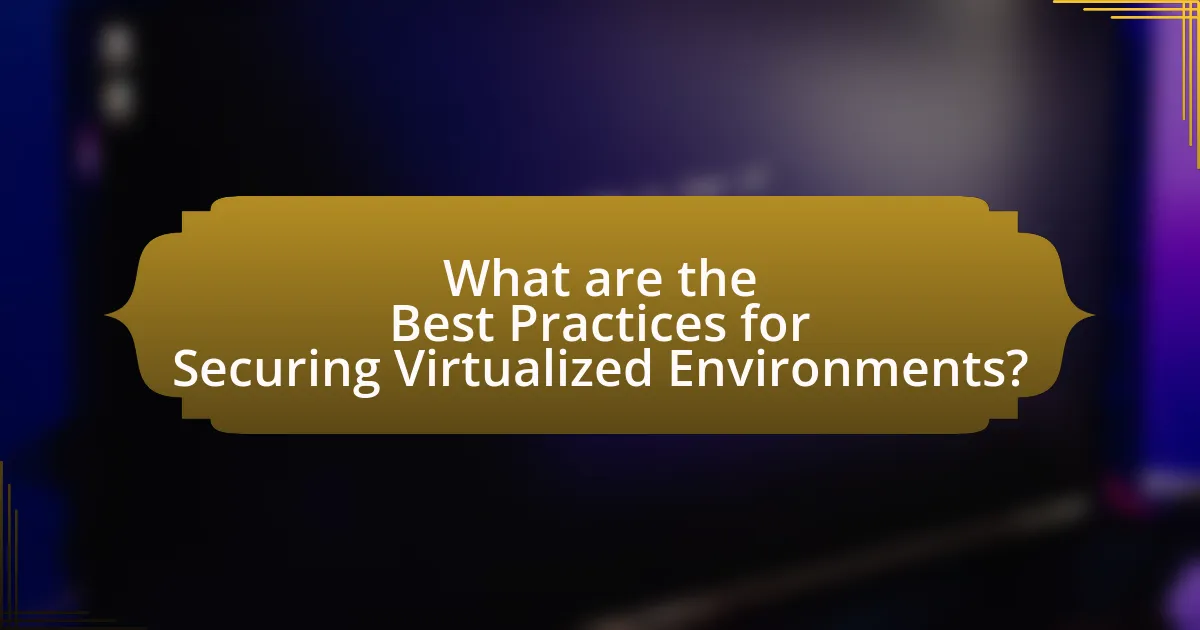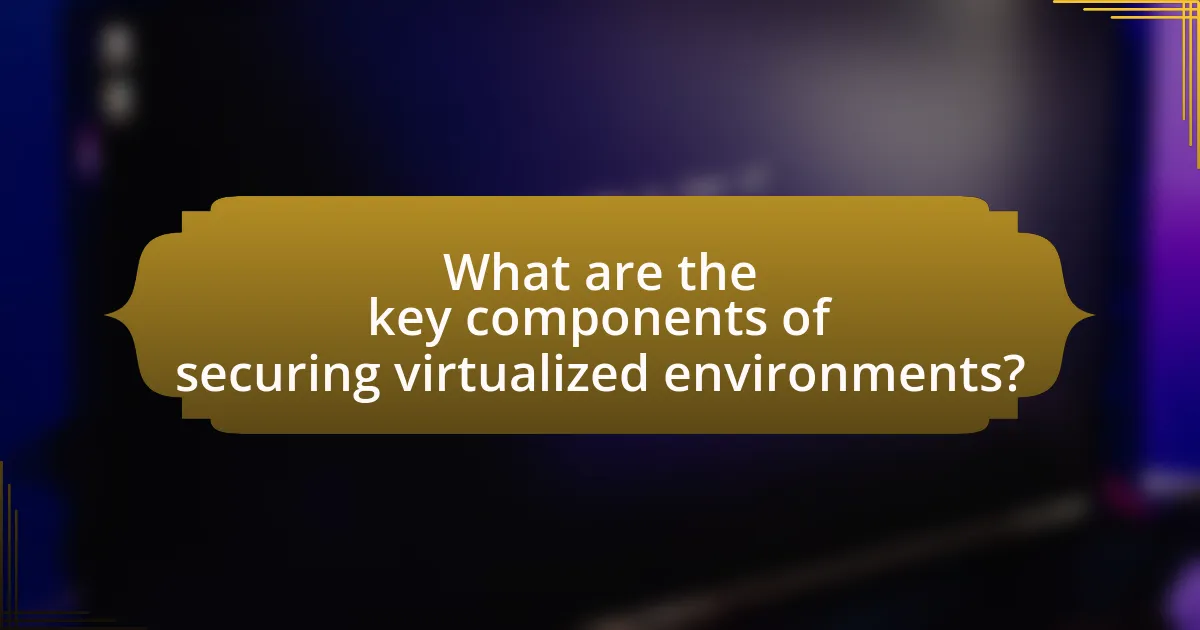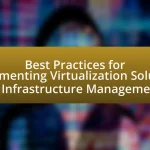The article focuses on best practices for securing virtualized environments, emphasizing the importance of strong access controls, regular updates, and network segmentation to mitigate unique vulnerabilities such as hypervisor attacks and VM escape. It outlines how virtualized environments differ from traditional ones in terms of security risks and discusses the critical role of hypervisor security, network segmentation, and compliance with regulations like GDPR and HIPAA. Additionally, the article highlights the necessity of continuous monitoring, incident response strategies, and the use of automated security tools to enhance the overall security posture of virtualized infrastructures.
What are the Best Practices for Securing Virtualized Environments?

The best practices for securing virtualized environments include implementing strong access controls, regularly updating and patching hypervisors and virtual machines, and utilizing network segmentation. Strong access controls ensure that only authorized personnel can manage virtual resources, reducing the risk of unauthorized access. Regular updates and patches are critical, as vulnerabilities in hypervisors can be exploited; for instance, a study by the National Institute of Standards and Technology highlights that timely patching can mitigate up to 85% of known vulnerabilities. Network segmentation limits the potential impact of a breach by isolating different virtual machines, thereby containing threats. Additionally, employing encryption for data at rest and in transit enhances security by protecting sensitive information from interception or unauthorized access.
How do virtualized environments differ from traditional environments in terms of security?
Virtualized environments differ from traditional environments in terms of security primarily due to their multi-tenancy and abstraction layers. In virtualized environments, multiple virtual machines (VMs) share the same physical resources, which increases the risk of cross-VM attacks, where a compromised VM can potentially access data or disrupt other VMs on the same host. Additionally, the abstraction of hardware resources in virtualization can create vulnerabilities if not properly managed, as misconfigurations can expose sensitive data or services. For instance, a study by the National Institute of Standards and Technology (NIST) highlights that virtualization introduces unique security challenges, such as hypervisor vulnerabilities and the need for robust isolation mechanisms to protect against unauthorized access.
What unique vulnerabilities are present in virtualized environments?
Virtualized environments face unique vulnerabilities such as hypervisor attacks, VM escape, and resource contention. Hypervisor attacks occur when an attacker targets the virtualization layer, potentially gaining control over multiple virtual machines (VMs). VM escape allows malicious code running in one VM to break out and access the host system or other VMs, compromising their security. Resource contention arises when multiple VMs compete for limited resources, which can lead to performance degradation and potential denial of service. These vulnerabilities highlight the need for robust security measures tailored to the complexities of virtualization.
How does the architecture of virtualization impact security measures?
The architecture of virtualization significantly impacts security measures by introducing layers of abstraction that can both enhance and complicate security protocols. Virtualization allows for the isolation of virtual machines (VMs), which can improve security by containing potential breaches within a single VM, preventing them from affecting the host or other VMs. However, this architecture also creates new attack surfaces, such as hypervisor vulnerabilities, which can be exploited to gain unauthorized access to multiple VMs. For instance, a study by the National Institute of Standards and Technology (NIST) highlights that hypervisor vulnerabilities can lead to escalated privileges and data breaches across virtualized environments. Therefore, while virtualization can enhance security through isolation, it also necessitates robust security measures to address the unique risks associated with its architecture.
Why is it important to secure virtualized environments?
Securing virtualized environments is crucial to protect sensitive data and maintain system integrity. Virtualization introduces unique vulnerabilities, such as hypervisor attacks and inter-VM threats, which can compromise multiple virtual machines if not properly secured. According to a 2021 report by the Ponemon Institute, 60% of organizations experienced a security breach in their virtualized environments, highlighting the need for robust security measures. Implementing security protocols helps mitigate risks, ensuring compliance with regulations and safeguarding against data breaches.
What are the potential risks of neglecting security in virtualized environments?
Neglecting security in virtualized environments can lead to significant risks, including data breaches, unauthorized access, and system vulnerabilities. These risks arise because virtualized environments often share resources, making it easier for attackers to exploit weaknesses in one virtual machine to gain access to others. For instance, a study by the Ponemon Institute found that 60% of organizations experienced a data breach due to inadequate security measures in virtualized environments. Additionally, without proper security protocols, malware can spread rapidly across virtual machines, compromising entire systems.
How can security breaches in virtualized environments affect organizations?
Security breaches in virtualized environments can significantly compromise organizations by exposing sensitive data and disrupting operations. When a breach occurs, attackers can gain unauthorized access to virtual machines, leading to data theft, loss of intellectual property, and potential regulatory penalties. For instance, a report by the Ponemon Institute indicates that the average cost of a data breach in 2021 was $4.24 million, highlighting the financial impact on organizations. Additionally, breaches can result in reputational damage, loss of customer trust, and increased scrutiny from regulators, further complicating recovery efforts.
What are the key components of securing virtualized environments?

The key components of securing virtualized environments include hypervisor security, network segmentation, access control, and regular security updates. Hypervisor security is critical as it serves as the foundation for virtual machines; vulnerabilities in the hypervisor can lead to breaches across all hosted environments. Network segmentation helps isolate virtual machines to limit the spread of potential attacks, while access control ensures that only authorized users can interact with the virtual infrastructure. Regular security updates are essential to patch vulnerabilities and protect against emerging threats, as evidenced by the fact that 60% of breaches exploit known vulnerabilities that could have been mitigated through timely updates.
What role does hypervisor security play in virtualization?
Hypervisor security is crucial in virtualization as it acts as the foundational layer that manages and isolates virtual machines. By ensuring that the hypervisor is secure, organizations can prevent unauthorized access and attacks that could compromise multiple virtual machines simultaneously. For instance, vulnerabilities in hypervisors can lead to hypervisor escape attacks, where an attacker gains access to the host system from a virtual machine, potentially affecting all other VMs. Therefore, implementing robust security measures, such as regular updates, configuration hardening, and monitoring, is essential to protect the hypervisor and, by extension, the entire virtualized environment.
How can hypervisor vulnerabilities be mitigated?
Hypervisor vulnerabilities can be mitigated through a combination of regular updates, configuration hardening, and monitoring. Regularly applying security patches and updates from hypervisor vendors reduces the risk of exploitation by addressing known vulnerabilities. Configuration hardening involves disabling unnecessary services and features, which minimizes the attack surface. Additionally, continuous monitoring for unusual activities can help detect potential breaches early. These practices are supported by industry standards and guidelines, such as those from the National Institute of Standards and Technology (NIST), which emphasize the importance of maintaining secure configurations and timely updates in virtualized environments.
What best practices should be followed for hypervisor configuration?
Best practices for hypervisor configuration include implementing strong access controls, regularly updating hypervisor software, and isolating virtual machines (VMs) to minimize security risks. Strong access controls ensure that only authorized personnel can manage the hypervisor, reducing the risk of unauthorized access. Regular updates are crucial as they address vulnerabilities and improve performance; for instance, a study by the National Institute of Standards and Technology highlights that timely patching can significantly reduce the attack surface. Isolating VMs prevents potential threats from spreading between them, enhancing overall security in a virtualized environment.
How can network security be enhanced in virtualized environments?
Network security in virtualized environments can be enhanced by implementing micro-segmentation, which involves dividing the network into smaller, isolated segments to limit lateral movement of threats. This approach allows for more granular control over traffic flows and policies, reducing the attack surface. According to a report by Gartner, organizations that adopt micro-segmentation can reduce the risk of data breaches by up to 80%. Additionally, employing robust access controls, regular security updates, and continuous monitoring of virtual machines further strengthens security by ensuring that only authorized users can access sensitive data and that vulnerabilities are promptly addressed.
What are the best practices for virtual network segmentation?
The best practices for virtual network segmentation include implementing a zero-trust architecture, utilizing VLANs for logical separation, and applying access control lists (ACLs) to restrict traffic between segments. Zero-trust architecture ensures that all users and devices are authenticated and authorized before accessing network resources, minimizing the risk of unauthorized access. VLANs allow for the creation of isolated network segments, which can enhance security by limiting the spread of potential threats. ACLs further enforce security policies by controlling which devices can communicate with each other across segments. These practices collectively enhance the security posture of virtualized environments by reducing attack surfaces and containing potential breaches.
How can firewalls and intrusion detection systems be effectively utilized?
Firewalls and intrusion detection systems can be effectively utilized by implementing them as complementary security measures to monitor and control network traffic. Firewalls act as barriers that filter incoming and outgoing traffic based on predetermined security rules, while intrusion detection systems analyze traffic patterns to identify and alert on potential threats.
For instance, deploying a firewall can prevent unauthorized access to virtualized environments by blocking malicious traffic, while an intrusion detection system can detect anomalies in network behavior, such as unusual login attempts or data exfiltration activities. According to a study by the National Institute of Standards and Technology, integrating these systems enhances the overall security posture by providing layered defense mechanisms, which is crucial in protecting sensitive data in virtualized environments.
What are the common tools and technologies for securing virtualized environments?

Common tools and technologies for securing virtualized environments include hypervisor security solutions, virtual firewalls, intrusion detection and prevention systems (IDPS), and endpoint security software. Hypervisor security solutions, such as VMware vSphere Security and Microsoft Hyper-V Security, protect the virtualization layer from unauthorized access and vulnerabilities. Virtual firewalls, like Cisco Virtual Security Gateway, provide network segmentation and traffic filtering within virtual environments. IDPS, such as Snort and Suricata, monitor network traffic for suspicious activities and potential threats. Endpoint security software, including Symantec Endpoint Protection and McAfee Total Protection, secures virtual machines by detecting malware and enforcing security policies. These tools collectively enhance the security posture of virtualized environments by addressing various attack vectors and ensuring compliance with security standards.
What security solutions are specifically designed for virtualization?
Security solutions specifically designed for virtualization include hypervisor security, virtual firewalls, and virtual intrusion detection systems (IDS). Hypervisor security focuses on protecting the virtualization layer itself, preventing unauthorized access and attacks that could compromise multiple virtual machines. Virtual firewalls provide network security tailored for virtual environments, allowing for granular control over traffic between virtual machines. Virtual IDS monitors network traffic within the virtual environment to detect and respond to potential threats. These solutions are essential for maintaining the integrity and security of virtualized infrastructures, as they address unique vulnerabilities associated with virtualization technology.
How do these tools integrate with existing security frameworks?
These tools integrate with existing security frameworks by enhancing visibility, automating compliance, and providing advanced threat detection capabilities. For instance, security tools can be aligned with frameworks such as NIST or ISO 27001, allowing organizations to map their security controls to established standards. This integration facilitates real-time monitoring and incident response, ensuring that virtualized environments adhere to regulatory requirements. Additionally, tools like SIEM (Security Information and Event Management) systems can aggregate data from various sources, enabling a comprehensive security posture that complements existing frameworks.
What are the benefits of using automated security tools in virtualization?
Automated security tools in virtualization enhance security by providing continuous monitoring, rapid threat detection, and streamlined compliance management. These tools automate routine security tasks, reducing human error and increasing efficiency in identifying vulnerabilities. For instance, automated patch management can significantly decrease the window of exposure to known vulnerabilities, as evidenced by studies showing that timely patching can reduce the risk of exploitation by up to 85%. Additionally, automated security tools facilitate real-time incident response, allowing organizations to mitigate threats more effectively and maintain the integrity of virtualized environments.
How can organizations ensure compliance in virtualized environments?
Organizations can ensure compliance in virtualized environments by implementing robust governance frameworks and continuous monitoring practices. Establishing clear policies that align with regulatory requirements, such as GDPR or HIPAA, is essential for guiding compliance efforts. Regular audits and assessments of virtualized systems help identify vulnerabilities and ensure adherence to these policies. Additionally, utilizing automated compliance tools can streamline the monitoring process, providing real-time insights into compliance status and facilitating timely remediation of any issues. This approach is supported by industry standards, such as ISO/IEC 27001, which emphasizes the importance of risk management and continuous improvement in information security practices.
What regulations and standards should be considered for virtualization security?
Regulations and standards that should be considered for virtualization security include the General Data Protection Regulation (GDPR), the Health Insurance Portability and Accountability Act (HIPAA), and the National Institute of Standards and Technology (NIST) Special Publication 800-53. GDPR mandates strict data protection and privacy measures for organizations handling personal data, which impacts how virtualized environments manage sensitive information. HIPAA sets standards for protecting health information, requiring secure handling of electronic health records in virtualized systems. NIST SP 800-53 provides a comprehensive framework for security and privacy controls, guiding organizations in implementing effective security measures in virtualized environments. These regulations and standards ensure compliance and enhance the security posture of virtualization deployments.
How can compliance audits be effectively conducted in virtualized settings?
Compliance audits can be effectively conducted in virtualized settings by implementing a structured framework that includes continuous monitoring, automated compliance checks, and thorough documentation of virtual environments. Continuous monitoring allows organizations to track compliance in real-time, ensuring that any deviations from regulatory standards are immediately identified and addressed. Automated compliance checks streamline the auditing process by using tools that assess configurations and security controls against established benchmarks, such as those provided by the Center for Internet Security (CIS). Thorough documentation of virtual environments, including detailed records of virtual machine configurations, access controls, and change management processes, provides auditors with the necessary information to evaluate compliance effectively. These practices collectively enhance the reliability and efficiency of compliance audits in virtualized settings.
What are the best practices for ongoing security management in virtualized environments?
The best practices for ongoing security management in virtualized environments include implementing regular security assessments, maintaining up-to-date patches, and enforcing strict access controls. Regular security assessments help identify vulnerabilities within the virtual infrastructure, while timely patch management ensures that known security flaws are addressed, reducing the risk of exploitation. Enforcing strict access controls limits the number of users who can interact with virtual machines, thereby minimizing potential attack vectors. Additionally, employing network segmentation can further isolate virtual machines, enhancing security by preventing lateral movement in case of a breach. These practices are essential for maintaining a robust security posture in virtualized environments.
How can organizations implement continuous monitoring and assessment?
Organizations can implement continuous monitoring and assessment by utilizing automated tools and frameworks that provide real-time visibility into their virtualized environments. These tools, such as Security Information and Event Management (SIEM) systems, enable organizations to collect, analyze, and respond to security events as they occur. Additionally, organizations should establish a baseline of normal activity to identify anomalies and potential threats effectively. Regular vulnerability assessments and penetration testing further enhance the monitoring process by identifying weaknesses before they can be exploited. According to a report by the Ponemon Institute, organizations that employ continuous monitoring can reduce the average time to detect a breach by 12 times, demonstrating the effectiveness of these practices in enhancing security.
What strategies can be employed for incident response in virtualized environments?
Effective strategies for incident response in virtualized environments include implementing a robust monitoring system, establishing clear incident response protocols, and utilizing automation tools for rapid containment and recovery. A robust monitoring system enables real-time detection of anomalies and potential threats, which is crucial in a dynamic virtualized environment where traditional security measures may fall short. Clear incident response protocols ensure that all team members understand their roles and responsibilities during an incident, facilitating a coordinated response. Automation tools can significantly reduce response times by quickly isolating affected virtual machines and restoring services from backups, minimizing downtime and data loss. These strategies are essential for maintaining security and operational integrity in virtualized environments.




